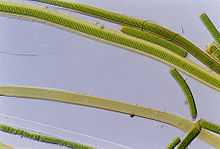Lyngbya
| Lyngbya | |
|---|---|
 | |
| Lyngbya sp. | |
| Scientific classification | |
| Kingdom: | Bacteria |
| Phylum: | Cyanobacteria |
| Order: | Oscillatoria |
| Genus: | Lyngbya [1] Agardh Ex Gomont, 1892 |
| Species | |
|
Lyngbya aestuarii | |
Lyngbya is a genus of cyanobacteria, unicellular autotrophs that form the basis of the oceanic food chain.
Lyngbya form long, unbranching filaments inside a rigid mucilage sheath. Sheaths may form tangles or mats, intermixed with other phytoplankton species. Lyngbya reproduce asexually. Their filaments break apart and each cell forms a new filament.[2]
Some Lyngbya cause the human skin irritation called seaweed dermatitis.[3]
Some Lyngbya species can also temporarily monopolize aquatic ecosystems when they form dense floating mats in the water.
References
- ↑ Lyngbya Agardh Ex Gomont, 1892 ITIS. Retrieved 2011-09-24.
- ↑ Lyngbya, Cyanobacteria, ALGAL-ED, Freshwater Ecology Laboratory, Connecticut College
- ↑ "Seaweed dermatitis". New Zealand Dermatological Society. 2007-02-24.
External links
| Wikimedia Commons has media related to Lyngbya. |
- Lyngbya Agardh 1824. Protist Information Server.
- Lyngbya species. Center for Aquatic and Invasive Plants. University of Florida IFAS.
- Guiry, M.D.; Guiry, G.M. (2008). "Lyngbya". AlgaeBase. World-wide electronic publication, National University of Ireland, Galway.